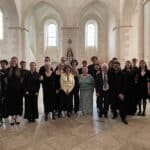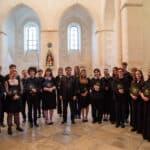The Duke of Edinburgh: a parting to remember
27 Apr 2021
St Edmund Hall’s Director of Music and BBC producer, Dr James Whitbourn, was appointed producer at St George’s Chapel Windsor for the the Duke Of Edinburgh’s funeral on Saturday 17 April, 2021. He shares his account of how he brought together the many different elements to broadcast the service to all BBC radio networks.
“A Pathé newsreel of 1958 shows a spirited Prince Philip, Duke of Edinburgh—a year or two younger than Prince William is today—commanding with his presence a packed Front Quad of St Edmund Hall before purposefully striding off down Queen’s Lane. He had come to deliver the Hall’s Royal Charter, granted the previous year, and to look over plans for the College’s ambitious programme of expansion. When shown by the College the newly-painted and immaculately-decorated room occupied by the organ scholar of the day (Michael Cansdale, now a St Edmund Fellow) the Duke astutely rejected its authenticity as ‘a typical undergraduate room’ and instead of admiring it as planned, engaged in conversation with the occupant on matters that interested him more. Sixty-three years later, his direct, no-nonsense approach found its final expression as his coffin was driven down the castle Ward on a green Land Rover, rather than a gun carriage, to its final resting place.
Because of my own longstanding relationship with the BBC, I was appointed producer at St George’s Chapel Windsor that day, responsible for the broadcast of the funeral service to all the BBC radio networks, working alongside my television colleagues and with a substantial radio team. We came together with all those from the chapel and castle who were called upon to bring together and fulfil the event in all its aspects, including liturgical, ceremonial and, of course, musical—the small choir, organists, brass players and pipers. Although I had produced broadcasts of two previous royal funerals and several royal weddings, this was an event like no other. The role of a producer of such events has similarities with the work of a composer: in both cases, much of our work has to be done in advance of the event itself. When working on a commissioned musical work, I always try to imagine myself sitting in the audience at the first performance. I try to anticipate the atmosphere and the movements of performers. Similarly, BBC Events producers try to imagine the scenes, the feelings, the power and the intricacies of an event which has not yet happened, and we plan for it so that others can experience the event authentically as it unfolds. The broadcast of the event itself is a time of intense concentration when each of the players focuses solely on their own part. The embarrassing announcement of the incorrect Oscar winner in 2017, when a busily-tweeting official had handed over the wrong envelope to the announcer, stands as a salutary warning to anyone who attempts simultaneously to experience an event and make it happen for others. My role was to help make it happen for others, working with a highly-skilled team of commentators, engineers and production colleagues, giving direction when needed and trusting in the abilities of others when that was all that was required.
The days before the event, in contrast, are experiential, and it is those times I have always treasured most, especially silent moments in Westminster Abbey or St George’s Chapel, when these buildings stand in expectant readiness. I love those periods of quiet and dedicated attention to detail, often casually observed. Normally, I try to imagine what the place will be like the following day, packed with human energy and breath. The Duke of Edinburgh’s funeral, though, uniquely lacked this contrast with preceding days. Even on the day itself, the chapel was almost empty and continued to house its lofty atmosphere in stillness. Those who were in the chapel wore face coverings and spoke little. The sounds were few, subtle but always telling. Radio is a less literal medium than its younger cousin, television, and its canvas is a combination of sonic actuality and poetic description, minimally used. With this information alone, the brain can assemble images that are as rich and powerful as those on screen, sometimes even more so. The tolling bell, the echoing footsteps on the stone floor, the military command: these are all emotive sounds that can call on our full attention. They tell a story that is authentic and uncluttered and which barely acknowledges the newly-painted walls or the immaculate decoration.
Emerging from the event afterwards, the chapel exudes a new atmosphere of stillness, quite different from that which had been there before. The Duke of Edinburgh’s final journey had been witnessed firsthand only by those inside the castle walls. It is a privilege to be able to be the eyes of others who look on or listen in and to help create the images that will remain in the national and international memory.”
Related News

